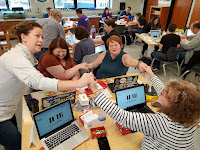"When my daughters and their peers enter the workforce in 10 years, the global economy will be even more competitive, automated and technology-driven than it is today."
 |
| Image Source: Medium.com |
In terms of new jobs, I've seen job titles such as "Innovation Director" and "Chief Learning Officer" among those of educators that have left the classroom and taken on a coaching role. Even these simple changes of mindset can have an impact.
"Schools can't keep pace with how quickly technology is changing."No ones fault specifically, but a product of the process. When schools learn of new technology, they must first research that technology and make sure it will have a positive impact on the students. If a school was to just buy every shiny new toy, the budget would be gone before Labor Day. The problem however is that some of the decision makers will spend so much time learning about a new technology that by the time they purchase it for the school, it's outdated. This leads to the "we already bought it, so you'd better use it" mentality that forces teachers to get creative.
"Content knowledge skills are relatively easy to learn, standardize and assess. This means they're also easy to automate."
 |
| Image Source: Make a Meme |
I understand the importance of standardized testing. In Pennsylvania, my ranking as a teacher was impacted on the scores of my students, but I still saw the importance of basic skills. Yes, we all have calculators on our phones, but quick math shouldn't require one. Additionally, when students rely so much on technology they aren't able to recognize extremely wrong answers.
Cited Source:
Chklovski, Tara. “Prioritizing STEM and Coding Won't Fill One of the Biggest Gaps in Education.” Quartz, Quartz, 25 Nov. 2019, qz.com/1752837/stem-and-coding-arent-enough-to-prepare-kids-for-the-future/.






















